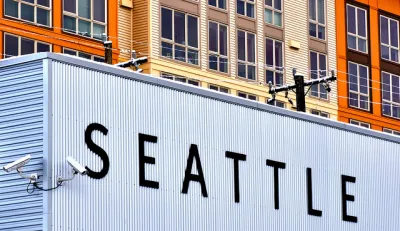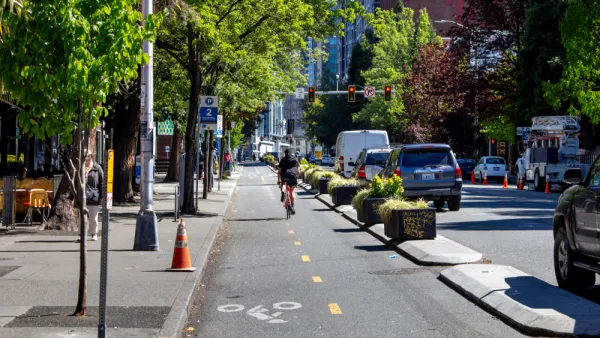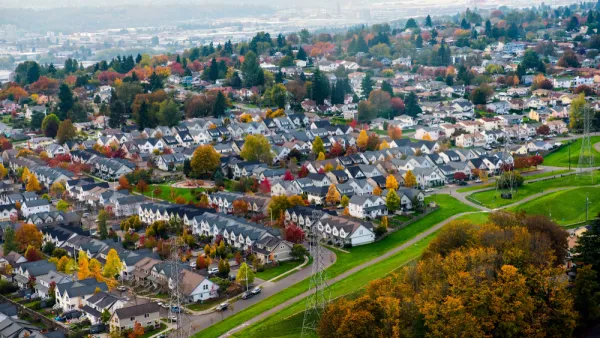Mayor Ed Murray released a 20-year growth plan, Seattle 2035, that retains LOS, but rather than measuring vehicle congestion, measures mode share, consistent with his vision for a green and sustainable city, but rattling The Seattle Times.

"Mayor Ed Murray today transmitted his proposal to update Seattle’s 20-year Comprehensive Plan to the Seattle City Council," states the mayor's May 3 press release. "Seattle 2035 [580-page PDF] focuses on equitable growth as Seattle expects gain 120,000 residents, 115,000 jobs, and 70,000 housing units over the next two decades."
Currently, level of service (LOS) is measured using the auto-centric volume/capacity (v/c) ratio, "but using it to measure system performance does not help achieve the Comprehensive Plan’s goal '…to safely and efficiently connect and move people and goods to their destinations',” states the 8-page section [PDF], "Proposed Change to Level of-Service Standards."
It is also inconsistent with the reality that Seattle has limited ability to increase the capacity of the street system, and it effectively means there are few practical remedies for a situation where the ratio is exceeded except through significant capital investment or changing the standard. [Hence, change the standard!]
New LOS standard
The City will measure LOS based on single occupant vehicle (SOV) mode share, as it focuses on increasing people-moving capacity by reducing travel that is occurring via the least space-efficient mode during the most congested period of the day.
By shifting travel from SOVs to more efficient modes operating on less-congested transportation networks, Seattle will allow more people to travel in the same amount of space...
The goal is not to reduce mobility, just to shift to modes more consistent with Seattle 2035. The policy change would need to be approved by the City Council.
Mode share also leverages the available and future capacity of the transit, bicycle, and pedestrian systems (which the City has the ability to expand and, in the case of bike and pedestrian networks, leverages substantial underutilized capacity).
Alas, the metric change has aroused at least one critic who sees the change as proof that Murray is "engaged in a war on cars," according to a column by Seattle Times editorial board writer Brier Dudley on the proposed LOS change. Do read his column as he concisely describes the proposed policy change, even if he is mistaken on what it amounts to.
Most of all, this shift gives the finger to those who drive cars, meaning nearly all residents and businesses.
And how does he suggest to deal with congested intersections? "If streets fail, cities can limit development until improvements are made."
Limiting developments in the name of mitigating traffic contributed to California's affordable housing crisis, which is why the state is now changing from LOS to the vehicle-miles traveled metric. Already, Seattle's housing prices are beginning to look a bit like San Francisco's. And those improvements he has in mind, even if the city could afford to do them, would be inconsistent with the plan to make the city more sustainable.
But leave it to Streetsblog's Angie Schmitt to explain why changing to a mode share LOS doesn't amount to a "war on cars."
Even before the release of Seattle 2035, the city was working to reduce single-occupant vehicle trips, as a post last August indicated. The draft plan "sets the goal of reducing solo driving for downtown work trips to 25 percent of mode share and reducing it to 10 percent of non-work trips by 2035," wrote Josh Cohen for Next City.
The mode split is already impressive. A February 2015 post indicated that "60% of commuters don’t drive at all [to downtown], instead opting for transit, walking, or cycling."
San Francisco approach
San Francisco Planning Commission adopted the vehicle miles traveled metric, notes a March post.
The commission voted to remove automobile delay as a significant impact on the environment and replace it with a vehicle miles traveled threshold for all California Environmental Quality Act, or CEQA, environmental determinations.
Hat tip to L.A. Metro Transportation Headlines.
FULL STORY: City’s vision for a carless Seattle doesn’t match reality

Analysis: Cybertruck Fatality Rate Far Exceeds That of Ford Pinto
The Tesla Cybertruck was recalled seven times last year.

National Parks Layoffs Will Cause Communities to Lose Billions
Thousands of essential park workers were laid off this week, just before the busy spring break season.

Retro-silient?: America’s First “Eco-burb,” The Woodlands Turns 50
A master-planned community north of Houston offers lessons on green infrastructure and resilient design, but falls short of its founder’s lofty affordability and walkability goals.

Test News Post 1
This is a summary

Analysis: Cybertruck Fatality Rate Far Exceeds That of Ford Pinto
The Tesla Cybertruck was recalled seven times last year.

Test News Headline 46
Test for the image on the front page.
Urban Design for Planners 1: Software Tools
This six-course series explores essential urban design concepts using open source software and equips planners with the tools they need to participate fully in the urban design process.
Planning for Universal Design
Learn the tools for implementing Universal Design in planning regulations.
EMC Planning Group, Inc.
Planetizen
Planetizen
Mpact (formerly Rail~Volution)
Great Falls Development Authority, Inc.
HUDs Office of Policy Development and Research
NYU Wagner Graduate School of Public Service




























